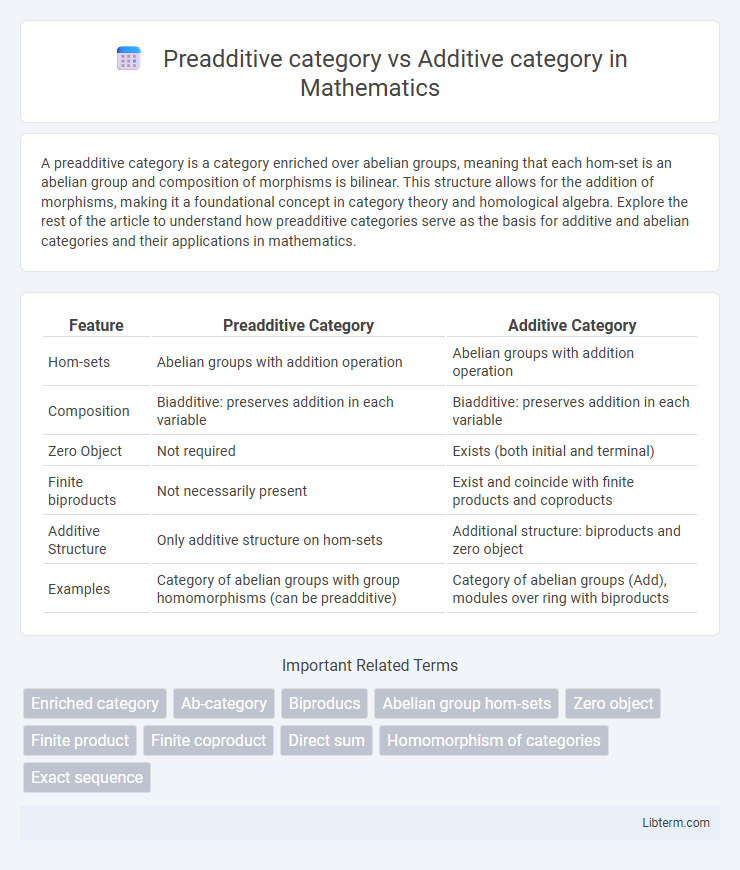A preadditive category is a category enriched over abelian groups, meaning that each hom-set is an abelian group and composition of morphisms is bilinear. This structure allows for the addition of morphisms, making it a foundational concept in category theory and homological algebra. Explore the rest of the article to understand how preadditive categories serve as the basis for additive and abelian categories and their applications in mathematics.
Table of Comparison
| Feature | Preadditive Category | Additive Category |
|---|---|---|
| Hom-sets | Abelian groups with addition operation | Abelian groups with addition operation |
| Composition | Biadditive: preserves addition in each variable | Biadditive: preserves addition in each variable |
| Zero Object | Not required | Exists (both initial and terminal) |
| Finite biproducts | Not necessarily present | Exist and coincide with finite products and coproducts |
| Additive Structure | Only additive structure on hom-sets | Additional structure: biproducts and zero object |
| Examples | Category of abelian groups with group homomorphisms (can be preadditive) | Category of abelian groups (Add), modules over ring with biproducts |
Introduction to Preadditive and Additive Categories
Preadditive categories are enriched over the category of abelian groups, meaning each hom-set carries an abelian group structure and composition is bilinear, which provides a foundation for additive operations between morphisms. Additive categories extend preadditive categories by requiring finite biproducts, allowing direct sums of objects and ensuring kernels and cokernels behave compatibly with the additive structure. These concepts play a crucial role in homological algebra and category theory by formalizing algebraic properties within categorical frameworks.
Foundations of Category Theory
A preadditive category is defined by having hom-sets equipped with abelian group structures where composition is bilinear, establishing a foundational framework in category theory for algebraic structures. An additive category extends this framework by also requiring finite biproducts, meaning objects have both products and coproducts that coincide, enabling richer algebraic constructions. These categories underpin the study of modules, representation theory, and homological algebra by formalizing additive and linear structures within categorical contexts.
Defining Preadditive Categories
A preadditive category is defined as a category enriched over the category of abelian groups, meaning each hom-set is equipped with an abelian group structure and composition maps are bilinear. In contrast, an additive category is a preadditive category that also admits all finite biproducts, combining categorical products and coproducts. The fundamental distinction lies in biproduct existence, where preadditive categories only require abelian group hom-sets and bilinearity of composition.
Key Features of Additive Categories
Additive categories are preadditive categories enriched with finite biproducts, meaning that they have both finite products and finite coproducts that coincide, providing a direct sum operation for objects. Morphism sets in additive categories form abelian groups, allowing hom-sets to be equipped with addition and enabling the construction of kernels and cokernels. This structure facilitates homological algebra by supporting exact sequences and enabling a richer categorical framework than mere preadditive categories.
Morphisms in Preadditive vs Additive Categories
Morphisms in a preadditive category form abelian groups, allowing composition to be bilinear and enabling additive structures without necessarily possessing all finite biproducts. In contrast, additive categories extend preadditive categories by requiring all finite biproducts to exist, ensuring morphisms support both additive and categorical product structures. The distinction centers on the presence of biproducts, influencing how morphisms can be combined and decomposed in these categorical frameworks.
Existence and Role of Zero Objects
A preadditive category is enriched over the category of abelian groups, ensuring that Hom-sets are abelian groups with bilinear composition, but it does not require the existence of zero objects or finite biproducts. An additive category extends a preadditive category by requiring a zero object, which serves as both initial and terminal, enabling zero morphisms between any pair of objects, and the existence of finite biproducts, allowing direct sums. The zero object in an additive category plays a crucial role in defining kernels, cokernels, and exact sequences, thereby supporting a richer structure for homological algebra.
Biproducts: The Defining Property of Additive Categories
Biproducts serve as the defining property that distinguishes additive categories from preadditive categories, ensuring that every finite set of objects possesses both products and coproducts that coincide. In additive categories, biproducts facilitate the decomposition of morphisms into projection and injection components, emphasizing a direct sum structure that preadditive categories lack. This structural feature enables additive categories to support a richer algebraic framework, crucial for homological algebra and category theory applications.
Examples Illustrating Preadditive and Additive Categories
Preadditive categories, such as the category of abelian groups or modules over a ring, have hom-sets that form abelian groups and composition is bilinear. Additive categories extend preadditive categories by requiring finite biproducts, as seen in the category of finitely generated free modules, where direct sums serve as biproducts. In these examples, the presence of biproducts distinguishes additive categories by allowing both product and coproduct structures that coincide, providing richer algebraic frameworks.
Applications in Algebra and Related Fields
Preadditive categories, where hom-sets form abelian groups and composition is bilinear, underpin the structure of modules and linear algebra, facilitating the study of morphisms in algebraic topology and representation theory. Additive categories extend this by allowing finite biproducts, crucial for constructing direct sums in homological algebra and enabling efficient manipulation of chain complexes. These frameworks support categorical approaches to rings, modules, and abelian groups, providing foundational tools for advanced research in algebra and related mathematical fields.
Summary: Comparing Preadditive and Additive Structures
Preadditive categories are enriched over the category of abelian groups, meaning their hom-sets are abelian groups and composition is bilinear, providing a foundational algebraic structure. Additive categories extend preadditive ones by requiring finite biproducts, combining product and coproduct structures, which allow for direct sum decompositions of objects. This distinction marks additive categories as a more structured environment supporting kernel and cokernel constructions fundamental in homological algebra.
Preadditive category Infographic

 libterm.com
libterm.com